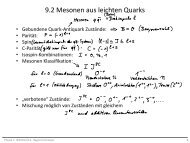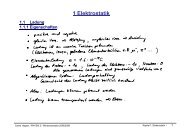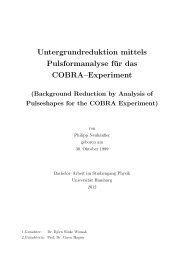Setup of a Drift Tube Muon Tracker and Calibration of Muon ...
Setup of a Drift Tube Muon Tracker and Calibration of Muon ...
Setup of a Drift Tube Muon Tracker and Calibration of Muon ...
You also want an ePaper? Increase the reach of your titles
YUMPU automatically turns print PDFs into web optimized ePapers that Google loves.
Chapter 2NeutrinosThe st<strong>and</strong>ard model <strong>of</strong> particle physics comprises only a few elementary particles:six quarks <strong>and</strong> six leptons as well as their anti particles plus the gauge bosonsmediating the forces between them. Out <strong>of</strong> these particles, the neutrinos are <strong>of</strong> amost interesting kind. They account for three <strong>of</strong> the leptons (ν e , ν µ , ν τ ), they areuncharged, each being a partner <strong>of</strong> one <strong>of</strong> the remaining—charged—leptons (e − , µ − ,τ − ). Originally assumed to be massless, it has recently been shown that neutrinoshave a tiny mass indeed. Although the st<strong>and</strong>ard model assumes a strict leptonnumber conservation within each family, neutrinos have the ability to change intoone another when traveling distances. This already shows that neutrinos <strong>of</strong>fer alarge potential for physics beyond the st<strong>and</strong>ard model. Neutrinos hardly interactwith matter, making it hard to detect them on the one h<strong>and</strong>, but on the other h<strong>and</strong>also <strong>of</strong>fering a great opportunity to use them as messenger particles. Their abilityto reach us from any source without any significant disturbance on their way makesit possible to use them as a probe <strong>of</strong> whatever they originate from.The first section <strong>of</strong> this chapter will give a brief introduction to the history<strong>of</strong> neutrino physics. This will be followed by a look at neutrino oscillations <strong>and</strong>the influence <strong>of</strong> matter on this effect. A particular look on solar neutrinos is thenpresented, followed by an overview <strong>of</strong> other neutrinos sources.2.1 A Brief History <strong>of</strong> Neutrino PhysicsThe neutrino was first postulated by Wolfgang Pauli in 1930 [1]. To explain thecontinuous energy spectrum <strong>of</strong> electrons in β decays as well as to maintain angularmomentum conservation, he assumed a neutral, invisible particle nowadays knownas the electron neutrino ν e to take part in the process.It was not until 1956 that the neutrino could actually be observed by FrederickReines <strong>and</strong> Clyde L. Cowan in an experiment called “Project Poltergeist” [2]. Atthe Savannah River reactor in the US state <strong>of</strong> South Carolina, they succeeded toobserve the inverse beta decay:¯ν e + p → e + + n.Reines <strong>and</strong> Cowan arranged to detect the γ-emission following the capture <strong>of</strong> theneutron in a nucleus, which together with two photons from the annihilation <strong>of</strong> thepositron with an electron gives a distinct signature for the process.5





